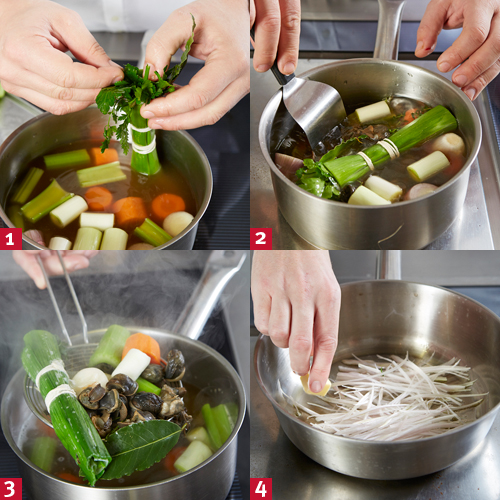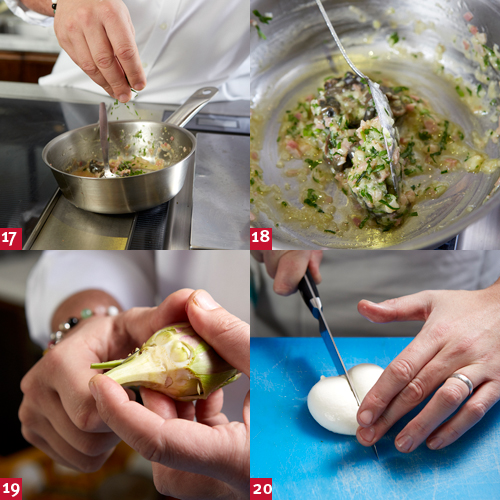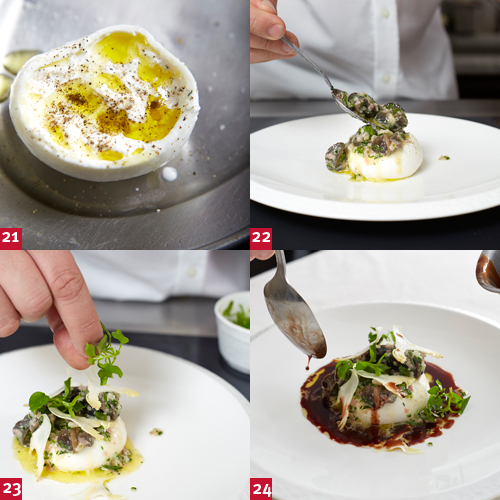Masterclass: Herefordshire snails at Hibiscus by Claude Bosi
Lyonnais chef Claude Bosi takes us through the creation of a dish of Herefordshire snails from his two-Michelin-starred restaurant, Hibiscus, in Mayfair. Michael Raffael reports
Itâs not a new branch of farming. The Romans did it, cosseting the gastropods as reverently as any farmer fattening geese for foie gras: âSnails were confined upon islands, so that they could not escape, and were fattened on milk, wine must and spelt. When they became so fat that they could not get back into their shells,â explains the Cambridge World History of Food, âthey were fried in oil.â
Snails slide in and out of fashion. Dishing them up with parsley and garlic butter (beurre dâescargots) and serving them in their shells adds a veneer of French cuisine to a bistro. It does little for them other than coat them in a cholesterol-raising bath.Â
Itâs a missed culinary trick. Snails have three things going for them. Their texture and taste, when properly prepared, are both unique. They also soak up other flavours. Smart chefs know this, but they have to work out ways of making them look good on a plate â" snails arenât obvious designer food.
Popped back in their shells they present well; out of it they are more challenging. It takes an experienced chef, like Claude Bosi at Hibiscus in Mayfair, to put six eye-catching charcoal-coloured nuggets on a burrata pillow with a bordelaise sauce. Itâs an upside-down take on the Burgundy classic escargots en meurette, where a poached egg sits on top of a red wine and snail soup.
**Planning
**The Hibiscus kitchen prepares a kilo batch of snails daily, sufficient to cover two services in the 70-seat restaurant. They arrive blanched and ready for poaching, the recipeâs first step.
Bordelaise sauce is part of the basic mise en place. Itâs also served with turbot on the current menu. The snails are finished individually to order. Bosi doesnât rely on sous vide, neither for storing the blanched snails nor after he has poached them.
The burrata is removed from the fridge at the start of service and the artichoke shavings are kept in acidulated water.
**Costing
**Bosi pays £18 per kg for the blanched, out-of-shell snails â" enough for about 50 starter portions. They are on the £49 lunch (three courses including half a bottle of wine) and £100 dinner menus.
**Poaching snails
**For the masterclass, Bosi prepared a poaching liquid based on four starter portions of snails. Scale up according to the batch size.
Serves 4 as a starter
- 500ml water (or light chicken stock)
- 50g diced carrot
- 50g leek
- 1 clove garlic
- 24 blanched snails
- 1 bouquet garni â" leek, celery, bay leaf and thyme
Put the water and vegetables in a pan and heat to simmering point (1). Add the snails and bouquet garni. Simmer for one hour and skim (2). Keep simmering until the snails are tender (3).
Bordelaise sauce
Serves 10
- 50g butter
- 60g fine brunoise shallots (preferably grey)
- 5g fresh thyme
- 1 bottle of Bordeaux red wine
- 400ml brown veal stock
- Salt
- Butter to finish the sauce (optional)
Melt the butter in a medium-sized sauté pan that can contain up to two litres. Add the shallots (4) and thyme and allow them to sweat over a very low flame. (5)
Add the wine and allow it to reduce at a gentle boil by roughly three-quarters **(6). **Pour the stock (see panel) onto the wine (7). Bring to simmering point and reduce slowly to about 350ml. Adjust the seasoning. The texture is right when it coats the back of a spoon (8).
Test the sauce for flavour. If it seems too acidic, incorporate a little butter before serving.
Herefordshire snails, burrata and bordelaise
Serves 1
- 10ml neutral oil
- 50g butter
- 30g fine brunoise banana shallots
- 10g fine brunoise prosciutto cotto (cooked ham)
- 6 large, poached snails
- 20ml snail poaching liquid (see panel)
- Sprig of thyme
- Salt
- Chopped tarragon, chervil and thyme leaves
- ½ burrata at room temperature
- 1tsp extra virgin olive oil
- 40ml Bordelaise sauce
- Raw artichoke bottom shavings
Warm the oil in a small sauté pan and melt half the butter without letting it sizzle (9). Add the shallots (10), ham and thyme (11). Let them sweat until theyâve softened (12).
Melt the remaining butter in a pan, and add the snails and then a little poaching liquor (13-14). Add the ham and shallots (15), then stew gently till itâs absorbed the liquid, for five to 10 minutes (16). Adjust the seasoning and remove the thyme. Just before serving, mix in the chopped herbs (17). The snails should be well-coated and full of flavour (18).
To prepare the artichoke, select small young ones that donât have any âfurâ in the middle. Trim the outer leaves and the stems (19). Cut off the tops to expose the hearts. Slice them as thinly as possible.
Season the burrata (20) and place it in the middle of the plate. Spoon the teaspoon of olive oil into the well in the middle (21).
Spoon the snails with the herbs and shallots onto the burrata (22). Add the artichoke shavings (23) and pour a cordon of sauce around the burrata. (25)
**Classic brown veal stock
**Spread 20kg of veal shin bones between two or three roasting tins. Brown without oil or fat in a very hot oven (250°C). Transfer to a stock pot and cover with 40 litres of water.
Stir in tomato purée to taste. Deglaze the pans with a litre of red wine and add to the pot with the bones. Boil, skim, and simmer at just below boiling point for six hours.
Add about four kilos of mirepoix together with a large bouquet garni of leek, celery leaves, bay leaves, parsley stalks and fresh thyme. Simmer for another six hours.
Remove the fat on the surface and strain through a chinois to stop it going cloudy.
Chefs and their snail recipes
- Heston Blumenthal Snail porridge
- Eric Chavot Snail bourguignon, meatball and potato espuma
- David Everitt-Matthias Snail and ground elder risotto
- Pierre Koffmann Crisp or soft ravioli of snails served as an amuse bouche
- Oliver Lešnik Snails in garlic butter
- Allan Picket Kent snail pithivier
- Alain Roux Petits choux garni dâune duxelle de champignons et escargots de Bourgogne braisés, nappés de sauce béarnaise
Tips
When making the brown stock, add the vegetables halfway through the process.
If you add butter (monter au beurre) to finish a sauce, donât beat or whisk it â" just shake it into the sauce.
Always cook out canned tomato purée to remove any hint of bitterness.
UK suppliers
Aylesbury Escargots www.aylesbury-escargots.co.uk
Dorset Escargot
www.dorsetsnails.co.uk
Kent Escargots www.kent-escargots.co.uk
LâEscargot Anglais 01432 760218
Claude Bosi
Itâs been eight years since Claude Bosi upped sticks and moved Hibiscus from Ludlow to London. He described the move as dangerous â" he had to give up a small but successful provincial restaurant where he was always on the stove, to move to a luxury, now 70-seat, W1 establishment.
The risk paid off, but he admits that the move suited his temperament: âAt heart, Iâm a city boy,â he says. Having learned his craft in Paris at Alain Passardâs three-Michelin-starred LâArpège, this rings true.
He noticed from the outset that a gulf separated the two types of clientele: âWhen you are in the countryside, you think thereâs not a great demand for this style of cuisine, but when you come to London you are competing with many other great restaurants. You have to fight to keep your regulars.â
His classic approach to French bourgeois cuisine hasnât changed, though: âMy cooking is similar, but itâs become lighter on the plate; less complicated. My philosophy and the mix of flavours is exactly the same.â
If anything has altered, it was his attitude to running Hibiscus. During the first four or five years he used his celebrity status to globe-trot, taking up the kind of invitations that land on the desks of chefs in the public eye. But no longer â" he likes being in control on the pass. Consistency has improved as a result. âI needed to come back to reality and realise that my job was cooking. Iâm not a movie star.â
He didnât see himself as a follower of food fashion, because he believed it would confuse his customers: âIf I want to have repeat trade, then my customers know that every time they come they will have a similar experience.â His current menus include updated versions of tiramisu and sticky toffee pudding.
What he has noticed is that there is no difference between a gastronomic restaurant in France and one across the Channel: âLondon is the place to be. You find chefs coming from all over the world because they want to be here.â

























